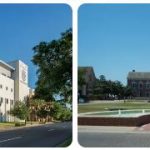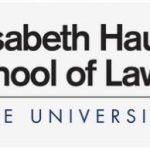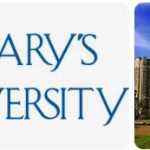Northeastern University School of Law was founded in 1898 as the first law school in Boston. It was originally known as the Northeastern College of Law and was located in the Boylston Building, near Boston Common. The school was founded to provide legal education to those who otherwise could not afford it, and offered a two-year curriculum with courses in contract law, criminal law, and evidence. In 1909, the school moved to its current location on Huntington Avenue. The move marked an important milestone for Northeastern Law as it allowed for expansion of its curriculum and student body. Over the next few decades, the school continued to grow in size and scope, offering more specialized courses such as international law and business law. By 1967, the college had become a full-fledged university with a four-year program leading to a Juris Doctor degree. In 1969, Northeastern University established its School of Law Library which is now one of the largest academic libraries in New England. Today, Northeastern University School of Law is one of the top ranked public law schools in the nation according to U.S News & World Report’s 2019 rankings and is renowned for its commitment to experiential learning opportunities through its Cooperative Legal Education Program (CLEP). Through CLEP students are able to gain real world experience by working at actual legal settings such as courtrooms or law firms while still enrolled at Northeastern University School of Law. This innovative program has helped mold some of today’s most influential lawyers who have gone on to shape national policy and shape our justice system for generations to come.
Northeastern University School of Law is located in the state of Massachusetts. As one of the leading law programs, Northeastern University School of Law has a high average LSAT score of 155-163 when recruiting new students. As a return, the median starting salary for law graduates reaches $85,000 per year. See the following table for detailed admissions information and career profiles of Northeastern University School of Law.
Admissions: Northeastern University
Northeastern University School of Law is one of the top law schools in the country, boasting a high admissions rate and a diverse student body. The median LSAT score for Northeastern students is 158, which puts them in the top 10% of all test takers, while the median GPA is 3.53. Additionally, Northeastern’s acceptance rate is 39%. The school also has a diverse student body with over 25% of enrolled students coming from underrepresented minority groups. With its strong academic reputation and commitment to diversity, Northeastern University School of Law provides an excellent learning environment for aspiring lawyers.
Northeastern Law offers several dual degree programs as well as joint degree programs with other universities like Harvard and Boston College. These programs allow students to gain expertise in two areas at once, giving them a competitive edge when they enter the job market. Additionally, Northeastern also has an extensive network of alumni across the country who are willing to provide mentorship and career advice to current students. This network allows current students to benefit from their peers’ experiences and get ahead in their legal careers while still at school.
| Fall 2019 Admissions and Enrollment Statistics | |
|---|---|
| Total number of full- and part-time applicants | 3,798 |
| Total number of full- and part-time acceptances | 1,280 |
| Overall acceptance rate | 33.7% |
| Total number of full- and part-time first-year students enrolled | 214 |
| Number of full-time program applicants | 3,798 |
| Number of full-time program acceptances | 1,280 |
| Full-time acceptance rate | 33.7% |
| Number of first-year full-time students enrolled | 214 |
| Number of part-time program applicants | N/A |
| Number of part-time program acceptances | N/A |
| Part-time acceptance rate | N/A |
| Number of first-year part-time students enrolled | N/A |
| Fall 2019 GPA and LSAT Scores | |
| 25th-75th percentile GPA scores for all students | 3.2-3.63 |
| 25th-75th percentile LSAT scores for all students | 155-163 |
| 25th-75th percentile undergraduate GPA for full-time students | 3.2-3.63 |
| 25th-75th percentile LSAT scores for full-time students | 155-163 |
| 25th-75th percentile undergraduate GPA for part-time students | N/A |
| 25th-75th percentile LSAT scores for part-time students | N/A |
Careers: Northeastern University
| Bar Statistics (Winter and Summer 2018 administrations) | |
|---|---|
| State where the greatest number of first-time test takers took the bar | MA |
| School’s bar passage rate for first-time test takers | 93.7% |
| Statewide bar passage rate for first-time test takers | 89.0% |
| Class of 2018 Graduates | |
| Total graduates | 198 |
| Graduates employed at graduation | N/A |
| Graduates known to be employed nine months after graduation | 94.1% |
| Starting Salaries of 2018 Graduates Employed Full-time | |
| 25th percentile private sector starting salary | $55,000 |
| Median private sector starting salary | $85,000 |
| 75th percentile private sector starting salary | $160,000 |
| Percent in the private sector who reported salary information | 60% |
| Median public service starting salary | $47,000 |
| Areas of Legal Practice (Class of 2018) | |
| Percent employed in academia | 3.0% |
| Percent employed in business and industry | 26.0% |
| Percent employed in government | 8.0% |
| Percent employed in all judicial clerkships | 13.0% |
| Percent employed in law firms | 34.0% |
| Percent employed in public interest | 16.0% |
| Percent employed in an unknown field | 0.0% |
| Percent employed in a judicial clerkship by an Article III federal judge | 1.0% |
| 2018 Graduates Employment Location | |
| Graduates employed in-state | 69% |
| Graduates employed in foreign countries | 2% |
| Number of states where graduates are employed | 21 |
| New England (CT, ME, MA, NH, RI, VT) | 76.0% |
| Middle Atlantic (NY, NJ, PA) | 4.0% |
| East North Central (IL, IN, MI, OH, WI) | 0.5% |
| West North Central (IA, KS, MN, MO, NE, ND, SD) | 2.0% |
| South Atlantic (DE, DC, FL, GA, MD, NC, SC, VA, WV) | 6.0% |
| East South Central (AL, KY, MS, TN) | 0.0% |
| West South Central (AR, LA, OK, TX) | 3.0% |
| Pacific (AK, CA, HI, OR, WA) | 6.0% |
| Mountain (AZ, CO, ID, MT, NV, NM, UT, WY) | 0.5% |
| Employment location unknown | N/A |
| Career Services | |
| (Data appear as originally submitted by this school) | |
| Career services operations | Practical experience is the cornerstone of a Northeastern law degree. Students work closely with career advisers every year throughout law school and graduate with one full year of legal work experience – developing skills, experience, confidence and contacts that greatly enhance job prospects. In fact, almost 40% of our students obtain their first post-graduate job with a former co-op employer. |
| Job Type | |
| Bar admission required or anticipated (e.g., attorney and corporate counsel positions, law clerks, judicial clerks) | 83.0% |
| J.D. preferred, law degree enhances position (e.g., corporate contracts administrator, alternative dispute resolution specialist, government regulatory analyst, FBI special agent) | 9.0% |
| Professional/other (jobs that require professional skills or training but for which a J.D. is neither preferred nor particularly applicable; e.g., accountant, teacher, business manager, nurse) | 5.0% |
| Nonprofessional/other (job that does not require any professional skills or training or is taken on a temporary basis and not viewed as part of a career path) | 4.0% |









